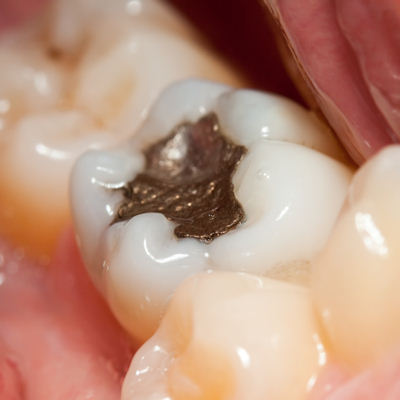
Even though the Food & Drug Administration has given their blessing to dental amalgam, their site still warns the general public about elemental mercury and the damage it can do to the body. They say that mercury vapor can possibly bioaccumlate, or slowly build-up in your kidneys or brain--although no studies have shown any negative effects so far.
But even though amalgam fillings have been used for over a century in the dentistry profession, the possible downsides of mercury should be food for thought. One dentist, a Dr. Tom Colpitts from Tulsa, even says that he's changed his mind over the years about their usage:
https://www.youtube.com/watch?v=m5f4Ixq04ik
Because mercury is a neurotoxin and since you can't just dispose of it easily into water supplies, Dr. Colpitts says that it's worth patients time to weigh the pros and cons.
The good news is that many offices, like Laguna Vista Dental, just offers composite dental fillings, which you can learn more about here: lagunavistadental.com/services/general-dentistry/dental-fillings/
The great thing about composite fillings is that they are very aesthetically pleasing as well as safe. The only downside of composite fillings is their tendency to wear down more quickly compared to other fillings. However, Drbicuspid.com released an article recently that outlines some of the most common causes for wear:
Reasons for Composite Failure Have Changed
Since resin composites were introduced, there has been an ongoing challenge to improve their clinical performance, particularly for use in posterior teeth," the authors wrote. "This has seen the introduction of hybrid, packable, nanofilled, low-shrinkage, and bulk-fill composites, but still the clinical effectiveness of posterior composite is questioned by many."
Dr. Alvanforoush is a doctoral student from the Melbourne Dental School at the University of Melbourne.
Reasons for failure
Direct resin composite restorations are becoming more popular, as patients prefer tooth-colored restorations because they offer a superior aesthetic appearance, and patients want to avoid the placement of new amalgam in their mouths. The study authors noted that substantial advancements and changes in composite materials and adhesive systems have taken place over the last 20 years, but no systemic literature review has assessed the clinical performance of posterior composite restoration . . .
The authors concluded that comparing the reasons for failure over the last two decades had revealed an important shift as secondary caries, postoperative sensitivity, and wear were reduced as failure factors in contrast with the increased role of tooth fracture, restoration fracture, and endodontic treatment as reasons for failure.
"The greater level of fracture may relate to the increase in size of restorations now being placed; however, more detailed data are needed," they wrote. Read the full article here . . .
Again, the top reasons for failure included things like tooth fracturing and the presence of secondary caries. While fracturing can sometimes occur due to traumatic accidents, it can also occur in minute amounts due to bruxism (teeth grinding). And since bruxism and secondary caries are both preventable (mouth guards and good oral hygiene), you can make composite fillings more viable with a little extra care.
And perhaps, one day patients won't even need fillings. According to another study presented at Drbicuspid.com, researchers believe they can restore tiny caries with a drug+collagen sponge that can regenerate dentine:
Study Offers New Treatment for Larger Caries
January 9, 2017 -- Soon you might be treating your patient's caries with a collagen sponge filled with a drug -- first tested to treat Alzheimer's patients -- that stimulates the natural ability of teeth to restore dentine.
A study published January 9 in Scientific Reports by researchers in the U.K. documented a new method of stimulating the renewal of living stem cells in tooth pulp. While still needing human clinical trials, this approach may allow large cavities to be repaired without the use of cement or fillings.
"The simplicity of our approach makes it ideal as a clinical dental product for the natural treatment of large cavities, by providing both pulp protection and restoring dentine," stated lead study author Paul Sharpe, PhD, in a press release. "In addition, using a drug that has already been tested in clinical trials for Alzheimer's disease provides a real opportunity to get this dental treatment quickly into clinics."
Sharpe is the head of the craniofacial development and stem cell biology division at the King's College London Dental Institute . . .
After removing caries decay, a tooth's soft inner pulp is exposed, and a natural dentine repair process begins. This process uses a form of stem cells in the patient's mouth that becomes new cells. These cells release a form of reparative dentine, according to the study authors. Read the full here . . .
Although this kind of restoration still has many kinks to work out, the fact that the study authors are eager to get this kind of treatment into clinics ASAP is exciting.
In the meantime, if patients focus on preventative dentistry measures, they can have long-lasting composite fillings and avoid amalgam altogether.
The following post Worried About Amalgam Fillings? Don’t Be–You’ve Got Options is available on: Laguna Vista Dental Dentistry Blog
Laguna Vista Dental
7915 Laguna Blvd, Ste 150
Elk Grove, CA 95758
(916) 684-3105
lagunavistadental@gmail.com
Google My Business Listing
Google Map
Directions to our office
Yelp Page

No comments:
Post a Comment